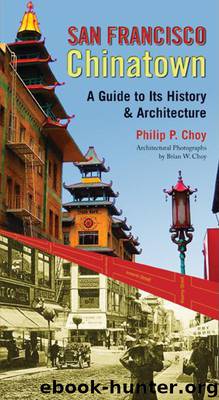San Francisco Chinatown by Philip P. Choy

Author:Philip P. Choy
Language: eng
Format: epub
Publisher: City Lights Publishers
SOUTHERN GRANT AVENUE
Bush to Sacramento Street
The aspiration of Look Tin Eli for a “veritable fairy palace filled with the choicest treasures of the Orient” began with the two imposing structures on the southwest and southeast corner of Grant and California Streets. After the ’06 Earthquake, the two blocks between California and Bush Street became the Oriental Bazaar of Chinatown. Every guidebook included a tour of the two blocks where souvenirs for the tourist and antiques for the serious collector could be found. The lanterns strung across the streets in the ’30s were not Chinese, however, but Japanese. The Japanese had become aware not only of the interest in Oriental art but also of the market for tourist trinkets, cheaply made and easily broken. The term “Made in Japan” was synonymous with inferior products, unlike the later reputation for quality of electronics companies such as Sony, Nikon, and Mitsubishi. In 1917, Japanese names such as Daibutsu, K. Yoshizawa Co., Okai Conpany, Nippon Trading, and Madam Butterfly stood out on southern Grant Avenue alongside Chinese firms like Sing Chong, Sing Fat, Canton Bazaar, Wing Sing Lung, and Shanghai Bazaar.
Chinese cocktail bars and lounges—which had begun to appear on Grant in the mid-1920s—began to prosper during 1940s, as San Francisco became a major port for wartime activities. Thousands of servicemen from all over the United States, either stationed in California or in transit, saw for the first time “real” Chinese who played music like Tommy Dorsey, Glenn Miller, and Benny Goodman, and also listened to Dudley Lee, known as “the Chinese Frank Sinatra,” at Andy Wong’s Skyroom. At the corner of Grant and Bush was Eddie Pond’s Kubla Khan, where Eddie played every Latin American rhythm instrument. Chorus girls dared to expose their legs; Noel Toy, billed as “the Chinese Sally Rand” after the famed fan dancer at the ’39 Treasure Island World’s Fair, danced with provocative grace, waving her two large feathered fans teasingly to hide her nude body. While escorting her at a recent Chinese Historical Society fundraiser, the present author remarked: “I recognize you!” She quipped: “How can you? I have my clothes on!” These Chinese musicians and dancers were the entrepreneurs of the entertainment world, daring to defy old traditional ways by entering show business.
Download
This site does not store any files on its server. We only index and link to content provided by other sites. Please contact the content providers to delete copyright contents if any and email us, we'll remove relevant links or contents immediately.
| African-American Studies | Asian American Studies |
| Disabled | Ethnic Studies |
| Hispanic American Studies | LGBT |
| Minority Studies | Native American Studies |
Cecilia; Or, Memoirs of an Heiress — Volume 1 by Fanny Burney(31326)
Cecilia; Or, Memoirs of an Heiress — Volume 3 by Fanny Burney(30929)
Cecilia; Or, Memoirs of an Heiress — Volume 2 by Fanny Burney(30886)
The Great Music City by Andrea Baker(21197)
We're Going to Need More Wine by Gabrielle Union(18067)
Bombshells: Glamour Girls of a Lifetime by Sullivan Steve(13102)
Pimp by Iceberg Slim(12924)
All the Missing Girls by Megan Miranda(12741)
Fifty Shades Freed by E L James(12445)
Norse Mythology by Gaiman Neil(11876)
Talking to Strangers by Malcolm Gladwell(11865)
Crazy Rich Asians by Kevin Kwan(8343)
Mindhunter: Inside the FBI's Elite Serial Crime Unit by John E. Douglas & Mark Olshaker(7831)
The Lost Art of Listening by Michael P. Nichols(6465)
Enlightenment Now: The Case for Reason, Science, Humanism, and Progress by Steven Pinker(6404)
Bad Blood by John Carreyrou(5763)
The Four Agreements by Don Miguel Ruiz(5504)
Weapons of Math Destruction by Cathy O'Neil(5032)
We Need to Talk by Celeste Headlee(4863)
